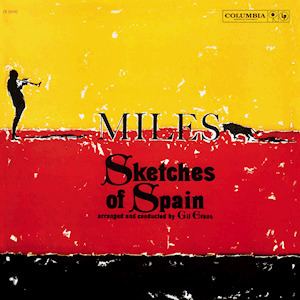Length 41:19 Release date 18 July 1960 | ||
 | ||
Released July 18, 1960 (1960-07-18) Recorded November 20, 1959; March 10, 1960 Sketches of Spain(1960) Someday My Prince Will Come(1961) Similar Miles Davis albums, Jazz albums | ||
Sketches of Spain is an album by Miles Davis, recorded between November 1959 and March 1960 at the Columbia 30th Street Studio in New York City. An extended version of the second movement of Joaquín Rodrigo's Concierto de Aranjuez (1939) is included, as well as a song called "Will o' the Wisp", from Manuel de Falla's ballet El amor brujo (1914–1915). Sketches of Spain is regarded as an exemplary recording of Third Stream, a musical fusion of jazz, European classical, and styles from world music.
Contents
Background
The album pairs Davis with arranger and composer Gil Evans, with whom he had collaborated on several other projects, on a program of compositions largely derived from the Spanish folk tradition. Evans explained:
[We] hadn't intended to make a Spanish album. We were just going to do the Concierto de Aranjuez. A friend of Miles gave him the only album in existence with that piece. He brought it back to New York and I copied the music off the record because there was no score. By the time we did that, we began to listen to other folk music, music played in clubs in Spain... So we learned a lot from that and it ended up being a Spanish album. The Rodrigo, the melody is so beautiful. It's such a strong song. I was so thrilled with that.
Concierto de Aranjuez
The opening piece, taking up almost half the record, is an arrangement by Evans and Davis of the adagio movement of Concierto de Aranjuez, a concerto for guitar by the contemporary Spanish composer Joaquín Rodrigo. Following the faithful introduction of the concerto's guitar melody on flugelhorn, Evans' arrangement turns into a "quasi-symphonic, quasi-jazz world of sound", according to his biographer. The middle of the piece contains a "chorus" by Evans unrelated to the concerto but "echoed" in the other pieces on the album. The original melody then reappears in a darker mode.
Davis plays flugelhorn and later trumpet, attempting to connect the various settings musically. Davis commented at rehearsal, "The thing I have to do now is make things connect, make them mean something in what I play around it". Davis thought the concerto's adagio melody was "so strong" that "the softer you play it, the stronger it gets, and the stronger you play it, the weaker it gets", and Evans concurred.
According to Davis' biographer Chambers, the contemporary critical response to the arrangement was not surprising, especially given the scarcity of anything resembling a jazz rhythm in most of the piece. Martin Williams wrote that "the recording is something of a curiosity and a failure, as I think a comparison with any good performance of the movement by a classical guitarist would confirm". The composer Rodrigo was also not impressed, but royalties from the arrangement brought him "a lot of money", according to Evans.
Critical reception
In a contemporary review for Down Beat, Bill Mathieu hailed Sketches of Spain as the one of the 20th century's most important musical works so far and a highly intellectual yet passionate record. He found Evans' compositions extremely well-crafted and Davis' playing intelligently devised, concluding in his review, "if there is to be a new jazz, a shape of things to come, then this is the beginning." Replying to suggestions that Sketches of Spain was something other than jazz, Davis said "it's music, and I like it". In The Rolling Stone Album Guide (2004), J. D. Considine called it "a work of unparalleled grace and lyricism", while Q magazine said it "took orchestral jazz in a new direction". Robert Christgau was less enthusiastic about the record and recalled being a young listener when it was released: "In 1960 [it] catapulted Davis into the favor of the kind of man who reads Playboy and initiated in me one phase of the disillusionment with jazz that resulted in my return to rock and roll".
For Sketches of Spain, Evans and Davis won the 1961 Grammy Award for Best Original Jazz Composition. In 2003, the album was ranked number 358 on Rolling Stone's list of the 500 greatest albums of all time. According to Acclaimed Music, it is the 419th most frequently ranked record on critics' all-time lists.
Song title meanings
- "Concierto de Aranjuez" was written about the gardens at Palacio Real de Aranjuez.
- "El Amor Brujo" is often translated as "The Bewitched Love" or "Love, the Sorcerer".
- "Alborada de Vigo" means "daybreak in the city of Vigo".
- "Saeta" is a type of religious song that is sung during the religious processions of Semana Santa in Seville, Spain.
- "Solea" is a form of Flamenco music.
Personnel
In alphabetical order (Note: this list encompasses the total musicians used on several sessions in late 1959 and early 1960. The actual number of players on the pieces was 19.)
Songs
1Concierto de Aranjuez16:22
2Will O' the Wisp3:51
3The Pan Piper4:00
